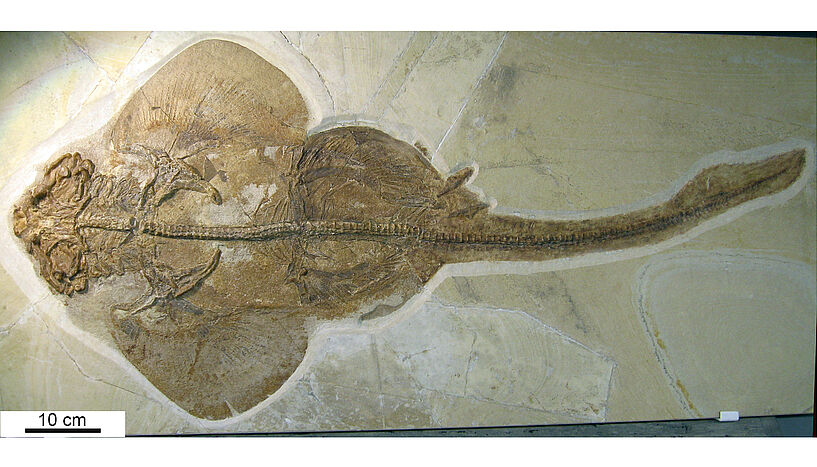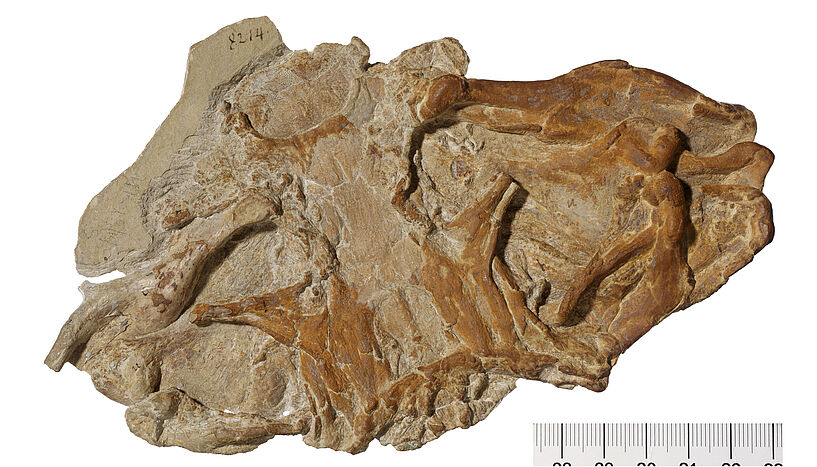Between shark and ray: The evolutionary advantage of the sea angels
04. August 2020Threatened with extinction despite perfect adaptation
Angel sharks are sharks, but with their peculiarly flat body they rather resemble rays. An international research team led by Faviel A. López-Romero and Jürgen Kriwet of the Institute of Palaeontology has now investigated the origin of this body shape. The results illustrate how these sharks evolved into highly specialised, exclusively bottom-dwelling ambush predators and thus also contribute to a better understanding of their threat from environmental changes. The study is published in the journal Scientific Reports.
The general picture of a shark is that of a fast and large ocean predator. Some species, however, question this image – for example angel sharks. They have adapted to a life on the bottom of the oceans, where they lie in wait for their prey. In order to be able to hide on or in the sediment, the body of angel sharks became flattened in the course of their evolution, making them very similar to rays, which are closely related to sharks.
Flattened body as indication for a successful lifestyle
The oldest known complete fossils of angel sharks are about 160 million years old and demonstrate that the flattened body was established early in their evolution. This also indicates that these extinct angel sharks already had a similar lifestyle as their extant relatives – and that this lifestyle obviously was very successful.
Angel sharks are found all over the world today, ranging from temperate to tropical seas, but most of these species are threatened. In order to understand the patterns and processes that led to their present low diversity and the possible consequences of their particular anatomy, the team has studied the body shapes of angel sharks since their origins using modern methods.
Today's species are very similar
For this purpose, the skulls of extinct species from the late Jurassic period (about 160 million years ago) and of present-day species were quantitatively analysed using X-ray and CT images and prepared skulls employing geometric-morphometric approaches. In doing so, the evolution of body shapes could be explained comparatively, independent of body size.
The results show that early angel sharks were different in their external shape, whereas modern species show a comparably lower variation in shape. "Many of the living species are difficult to identify on the basis of their skeletal anatomy and shape, which could be problematic for species recognition," explains Faviel A. López-Romero.
Angel sharks are well adapted, but react slowly to environmental changes
It has been shown that in living species the individual parts of the skull skeleton are more closely integrated than in their extinct relatives. This led to a reduced variability in appearance during the evolution of angel sharks. "The effect of integrating different parts of the skull into individual, highly interdependent modules can lead to a limited ability to evolve in different forms, but at the same time increases the ability to successfully adapt to specific environmental conditions," explains Jürgen Kriwet.
In the case of the angel sharks, increasing geographical isolation resulted in the development of different species with very similar adaptations. "But modular integration also means that such animals are no longer able to react quickly to environmental changes, which increases their risk of extinction," concludes Jürgen Kriwet.
Publication in Scientific Reports:
Evolutionary trends of the conserved neurocranium shape in angel sharks (Squatiniformes, Elasmobranchii).
López-Romero, F. A., Stumpf, S., Pfaff, C., Marramà, G., Johanson, Z. & Kriwet, J. in: Scientific Reports,
DOI: 10.1038/s41598-020-69525-7
Wissenschaftlicher Kontakt
Univ.-Prof. Dipl.-Geol. Dr. Jürgen Kriwet
Stv. Leiter des Instituts für PaläontologieUniversität Wien
1090 - Wien, Althanstraße 14
+43-1-4277-535 20
+43-664-60 277-535 20
juergen.kriwet@univie.ac.at
Rückfragehinweis
Alina Birkel, BA BA
Pressebüro der Universität WienUniversität Wien
1010 - Wien, Universitätsring 1
+43-1-4277-175 36
+43-664-60277-175 36
alina.birkel@univie.ac.at
Downloads:
Abb_3_02.jpg
Dateigröße: 2,17 MB
Abb_4_01.jpg
Dateigröße: 2,09 MB


